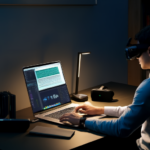The Future of Wearables: Beyond Fitness Trackers
Wearable technology has come a long way since its inception, evolving from simple step counters to sophisticated devices capable of monitoring heart rates, sleep patterns, and even stress levels. While fitness trackers have dominated the market for years, the future of wearables promises to transcend these boundaries, offering transformative applications across diverse industries. This article delves into the advancements in wearable tech, its integration with other sectors, emerging use cases, ethical concerns, and predictions for what lies ahead.
Advancements in Wearable Technology
The rapid pace of technological innovation has propelled wearables into new realms of possibility. Today’s devices are smaller, smarter, and more versatile than ever before. Advances in sensors, artificial intelligence (AI), and miniaturization have enabled wearables to capture an unprecedented amount of data while maintaining user comfort. For instance, flexible electronics and biocompatible materials allow devices to conform seamlessly to the human body, enhancing both functionality and aesthetics.
Beyond hardware improvements, software innovations are equally pivotal. Machine learning algorithms can now process vast amounts of data in real-time, providing users with actionable insights tailored to their unique needs. These developments pave the way for wearables that not only monitor but also predict and adapt to individual behaviors and preferences.
Integration with Other Industries
Fashion and Wearables
One of the most exciting intersections of wearable technology is with the fashion industry. Designers are increasingly collaborating with tech companies to create smart clothing and accessories that blend style with functionality. From jackets embedded with heating elements to jewelry that doubles as notification hubs, these innovations cater to consumers who value both form and function. The rise of “tech couture” demonstrates how wearables can transcend utilitarian purposes, becoming integral components of personal expression.
Healthcare Revolution
In healthcare, wearables are transforming patient care by enabling continuous monitoring and early detection of potential health issues. Devices like smartwatches equipped with ECG capabilities or glucose-monitoring patches empower individuals to take charge of their well-being. Moreover, remote patient monitoring facilitated by wearables allows doctors to track vital signs without requiring frequent hospital visits, reducing costs and improving outcomes.
Workplace Productivity
Wearables are also making waves in professional environments. Employers are leveraging these devices to enhance workplace safety and productivity. For example, smart helmets equipped with AR displays assist construction workers in visualizing blueprints on-site, while fatigue-detecting wearables help prevent accidents in high-risk industries. Additionally, corporate wellness programs incorporating wearables encourage healthier lifestyles among employees, ultimately boosting morale and performance.
Emerging Use Cases
Augmented Reality (AR) Wearables
Augmented reality wearables represent one of the most promising frontiers in this space. Smart glasses and headsets overlay digital information onto the physical world, creating immersive experiences that extend beyond entertainment. In fields like education, AR wearables enable interactive learning by bringing textbooks to life. Meanwhile, retail businesses use them to provide customers with virtual try-ons, enhancing shopping convenience.
Biometric Monitoring
As sensor technology becomes more advanced, wearables are poised to delve deeper into biometric monitoring. Devices capable of analyzing sweat composition, detecting pathogens, or measuring hydration levels could revolutionize preventive medicine. Such innovations would allow for earlier intervention in diseases and offer personalized recommendations based on individual biomarkers.
Privacy and Ethical Concerns
While the potential of wearables is immense, it is accompanied by significant privacy and ethical challenges. The vast amount of sensitive data collected by these devices raises concerns about security breaches and misuse. Unauthorized access to health metrics or location history could lead to identity theft or discrimination in areas like insurance coverage.
Moreover, questions arise regarding consent and transparency. Users may not always be fully aware of how their data is being used or shared with third parties. To address these issues, manufacturers must prioritize robust encryption protocols and adopt clear policies around data collection and usage. Policymakers also play a crucial role in establishing regulations that protect consumer rights without stifling innovation.
Predictions for Future Innovations
Looking ahead, the trajectory of wearable technology suggests several key trends. First, we can expect greater interoperability between devices, allowing seamless integration into broader ecosystems. Imagine a scenario where your smartwatch communicates with your home automation system to adjust lighting based on your mood or energy levels.
Second, wearables will likely become more invisible yet omnipresent. Advances in nanotechnology may lead to implants or skin patches that operate discreetly beneath the surface, eliminating the need for external gadgets altogether. This shift would blur the line between humans and machines, raising philosophical questions about identity and autonomy.
Finally, sustainability will emerge as a critical focus area. As environmental awareness grows, there will be increased demand for eco-friendly materials and energy-efficient designs. Companies that prioritize green practices in their product development stand to gain a competitive edge in the marketplace.
Conclusion
The future of wearables extends far beyond fitness trackers, heralding a new era of interconnectedness and empowerment. By integrating with industries such as fashion, healthcare, and the workplace, these devices are reshaping how we live, work, and interact with our surroundings. Emerging technologies like AR and advanced biometric monitoring hold untapped potential, while privacy and ethical considerations underscore the importance of responsible innovation.
As we stand on the cusp of this technological revolution, one thing is certain: wearables will continue to evolve in ways that challenge our imagination and redefine the boundaries of possibility. Whether through enhancing daily convenience, safeguarding health, or fostering creativity, the next generation of wearables promises to enrich lives in profound and unexpected ways.

